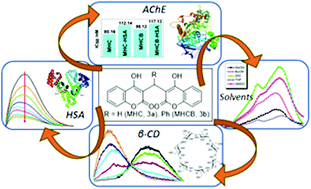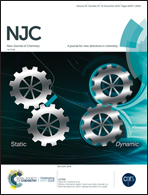Fluorescence solvatochromism and modulated anticholinergic activity of novel coumarin compounds sequestered in human serum albumin nanocavities†
Abstract
A coumarin compound, 3,3′-methylenebis(4-hydroxy-2H-chromen-2-one) (MHC), and its substituted derivative, 3,3′-(phenylmethylene)bis(4-hydroxy-2H-chromen-2-one) (MHCB), possess potent anticholinergic activities, which were found to be reduced significantly in the presence of human serum albumin (HSA). The molecular interactions responsible for sequestering MHC and MHCB were explored by steady-state and time-resolved fluorescence using the modulated solvatochromic behavior of the probes as a fluorescent marker. A quantitative description of the different solvent parameters responsible for the notable solvent-dependent photo-physical properties of the investigated systems was extracted from multiple linear regression analysis of the experimental data using the Kamlet–Taft and Catalán formalisms. A series of complimentary studies involving circular dichroism measurement and molecular docking calculations revealed that the binding of both coumarin derivatives resulted in the stabilization of the α-helical structure of human serum albumin (HSA). However, significant differences in binding mechanism were noted in terms of the strength, mode and principal forces responsible for the spontaneous association of the probes into the protein-binding domain.



 Please wait while we load your content...
Please wait while we load your content...